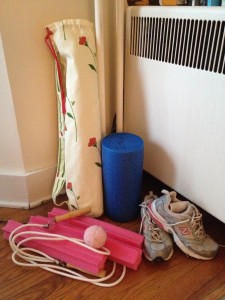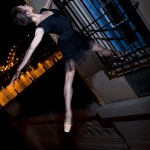by Emily Kate Long

It’s the most wonderful time of the year…Nutcracker season, of course! Nutcracker has never lost its magic for me. The fire was lit inside my nine-year-old soul as I hid under Mother Ginger’s skirt with eleven other curled, beribboned, lipsticked little girls, wanting more than anything to someday sit on the glittering throne upstage center. Fifteen years later, that throne is my domain for half an hour each Nutcracker night until a tiara and a tutu transform Clara into the Sugar Plum Fairy, bringing all her (and my) childhood dreams to life.
That’s the candy coating, anyway. Nutcracker is not a kind ballet, physically speaking. Classical pas de deux are lopsided as a rule, and it sure doesn’t feel great to sit still on foam-covered plywood for thirty minutes before dancing one. Many companies’ Nut runs are a dozen or fifty shows in duration, or involve extensive touring. Injuries are often rampant this time of year. In preparation for all things Nutty, this installment of Finding Balance is an early Christmas present to dancers in Nutcrackers everywhere: the Cross-Training Special (or, How to Survive Nut Without Cracking).
The first (and probably, the most important) step in developing an effective cross-training program is to identify what your general and specific weaknesses are, and to realize that they will (and should!) continually change as your technique and choreography do. For example, most ballet dancers are stronger/tighter on the left side and looser/weaker on the right, and overall our adductors and hamstrings tend to be weak. That’s a general and probably constant issue to address. Specifically, if choreography involves one-sided, one-directional, or very repetitive movement (many releves on the right foot, leg extensions mostly to the front, consecutive press lifts, etc.), building opposite or complementary actions into cross-training can prevent or alleviate symptoms of overuse.
Dancing alone can’t provide the strength to dance well, and it really pays off to be proactive. Time and money are two things most dancers need a little more of, and we can save both long-term (along with our sanity) if we take good care of ourselves to begin with. My routine is one I’ve developed and adapted to meet my particular needs, but it’s always evolving. I’m sharing it not because it’s a generic solution to everyone’s problems, but because of how much I’ve learned about my body and my dancing from developing tools to help myself.
I start by jogging either in the pool or on the treadmill to warm up for ten to fifteen minutes. Neutrality is the focus here: parallel legs, well-aligned spine, relaxed shoulders, standing on the whole foot with evenly-spaced strides, using all my joints (toes, ankles, knees, hips) to propel me. In the pool, I tag on about five minutes of jogging with flexed ankles traveling forward and backward. Eliminating the feet as a locomotive force increases the engagement of my upper body to move me through the water. Sustained dorsiflexion of the ankle also counteracts the sustained plantar flexion ballet requires and strengthens the underused muscles of the shin. On the treadmill, I alternate toe-strike jogging with heel-strike walking to engage the front and back of the leg evenly.
Once I get my circulation going and my heart rate elevated, I direct my focus from proximal to distal—core, limbs, extremities—then finish with full-body mobility/coordination work and some balance exercises.
Planks are pretty much a magic bullet for core strength. Working to minimize the engagement of the glutes, trapezius, and quadriceps forces the hamstrings, psoas, latissmus, deltoids, and pectorals to step it up. In the pool, prone flutter-kicking with a noodle or kickboard is roughly equivalent to a plank. On land, the variations are endless: planks can be done with hands or feet on a medicine or Balance ball, or with one hand or leg removed. On land, I also like to do a lot of Pilates work that contains side bends and twists. Holding a tennis ball or medicine ball between my knees adds a challenge for my adductors and maximizes hip stability. Balanced Body’s website has tons of Pilates podcasts to download.
Next, I shift my focus to working my limbs simply and freely while maintaining whatever core stability I just achieved. In the shallow end of the pool, I concentrate on letting my spine hang neutral, with the assistance of water noodles under each arm or in each hand for resistance, while folding my legs into high Italian changments and emboites to arabesque. For my hamstrings, I also employ a standing version of the Pilates single-leg kick, adding a flat-foot chug to coordinate with each pulse of the working leg. In the deep end, I suspend myself upright from the noodles and work on adduction with a turned-in ciseaux action. The water gives away every hidden imbalance in the body—you know you’re crooked if you start turning in circles, tipping over, or floating sideways!
For my limbs on land, I lay supine with my feet propped up on a balance ball. With legs extended and hips off the floor, I can work on psoas and hamstring strength by doing enveloppes, developpes, and releves lents to the front from sixth and a small first position. I also include forward bends through flat back holding a medicine ball or dumbbells, sometimes standing on an unstable surface (BOSU, pillow, or several layers of mats stacked up).
Now my feet get some attention, with a little extra work on the weaker right one. In the pool, I work through a series of sautés, paying a lot of attention to fully articulating my feet and landing with even weight distribution on the whole foot: one minute in first, one minute on each leg, and a fourth minute on two feet again in first or sixth. On land, it’s a series of foot roll-ups and arch doming while seated in a chair or on the balance ball. More on that here:
Once all my body parts know their respective jobs and are performing them to my satisfaction, they get challenged to just stand still and “be normal.” In the pool, it’s a struggle just to stand in parallel on one foot. My less stable right leg goes first, then left and right again. Once that goes well I add some simple arm movements—up and down, front and back. On land, I balance on each parallel leg with closed eyes, then move on to parallel and moderately turned-out one-legged balanced on the BOSU. The right leg gets double-duty here, too.
I finish with sprints in the pool. On land, I end with the jump rope and a few rounds of the Turkish get-up or Sun Salutations at a brisk pace. That’s followed by twenty or thirty minutes in the sauna, some quality time with the roam roller, and a thorough stretch.
Readers, what’s your preferred cross-training method? What are your greatest cross-training challenges? Please share your stories in the comments section!

BIO: Assistant Editor Emily Kate Long began her dance education in South Bend, Indiana, with Kimmary Williams and Jacob Rice, and graduated in 2007 from Pittsburgh Ballet Theatre School’s Schenley Program. She has spent summers studying at Ballet Chicago, Pittsburgh Youth Ballet, Pittsburgh Ballet Theatre School, Miami City Ballet, and Saratoga Summer Dance Intensive/Vail Valley Dance Intensive, where she served as Program Assistant. Ms Long attended Milwaukee Ballet School’s Summer Intensive on scholarship before being invited to join Milwaukee Ballet II in 2007.
Ms Long has been a member of Ballet Quad Cities since 2009. She has danced featured roles in Deanna Carter’s Ash to Glass and Dracula, participated in the company’s 2010 tour to New York City, and most recently performed principal roles in Courtney Lyon’s Sleeping Beauty, The Nutcracker, and Cinderella. She is also on the faculty of Ballet Quad Cities School of Dance, where she teaches ballet, pointe, and repertoire classes.




